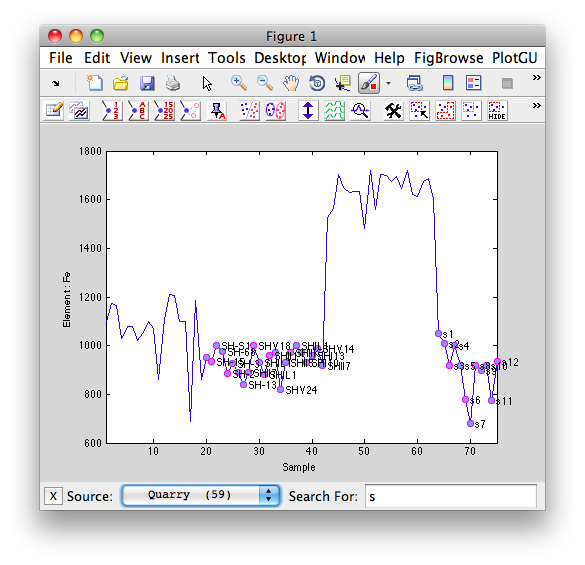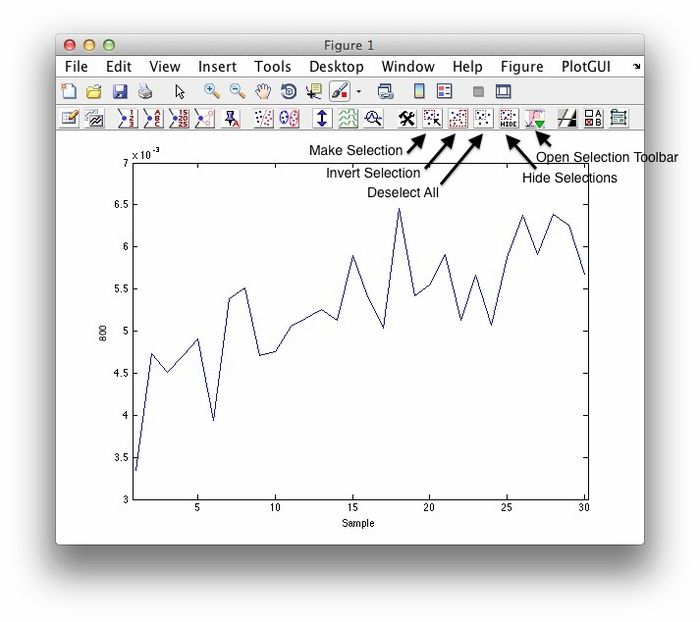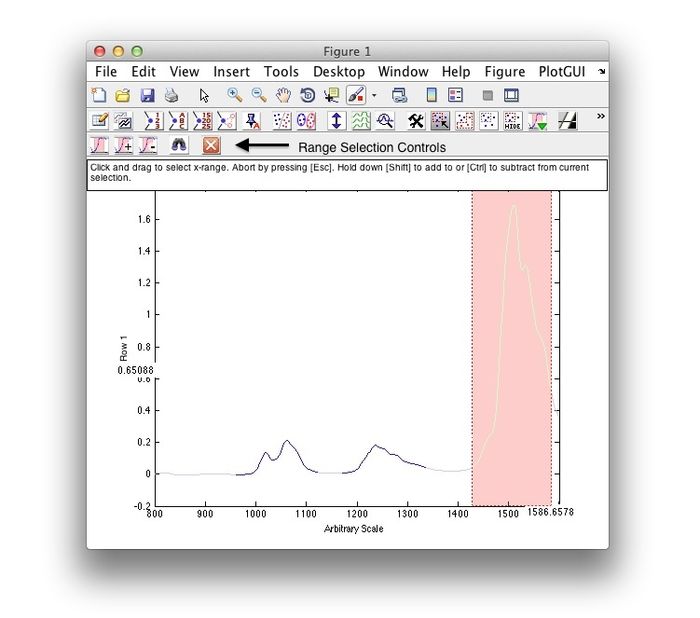Plot Controls: Layout 2: Difference between revisions
imported>Scott |
|||
| (12 intermediate revisions by 3 users not shown) | |||
| Line 184: | Line 184: | ||
|} | |} | ||
{| | |||
|- valign="top" | |||
| | |||
* To create or edit the Axisscale of the selected data, click Edit > Set Axis Scale of Selection OR use right click and select Set Axis Scale. | |||
|} | |||
:'''Note:''' This will clear the current model. | |||
{| | {| | ||
| Line 324: | Line 335: | ||
Selecting '''Search Bar''' from the '''Edit''' menu in the plot controls will open a toolbar at the bottom of the current plot. Depending on the mode being plotted, the appropriate fields and sets will be available in the Source drop-down menu. Typing a term in the Search For text field will automatically select data that matches the term. | Selecting '''Search Bar''' from the '''Edit''' menu in the plot controls will open a toolbar at the bottom of the current plot. Depending on the mode being plotted, the appropriate fields and sets will be available in the Source drop-down menu. Typing a term in the Search For text field will automatically select data that matches the term. | ||
[[Image:Pgsearchbar.png | [[Image:Pgsearchbar.png]] | ||
* Search terms are case insensitive unless surround by double quotes (""). | * When searching for numeric fields (class or axisscale), numeric value is implied with square brackets ([]) or with relational operators (<, >, >=, <=). | ||
* When using relational operators, the use of logical terms "and" and "or" can be combine multiple comparisons: <tt><3 or >5</tt> | |||
* Search terms are case insensitive unless surround by double quotes (""). Note the image above, the term (s) is searched for case insensitive, if the term had been ("S") on the SH samples would have been selected. | |||
* Regular Expressions can be used for searching text with the prefix (re:). | |||
* A "informal" wildcard (*) can used in the search term. The wildcard acts similar to SQL wildcards. | * A "informal" wildcard (*) can used in the search term. The wildcard acts similar to SQL wildcards. | ||
* | * Sample Index can be used for selecting via indexing with the prefix (si:). | ||
* | |||
{| class="wikitable" border="1" | |||
|+ Examples String Searches (Label/Class fields) | |||
! Term !! Description | |||
|- | |||
| s || Finds all values with a capital or lower case s. | |||
|- | |||
| "S" || Finds only values with capital s. | |||
|- | |||
| s* || Finds values starting with s. | |||
|- | |||
| re:\d{2} || Regular expression finds values containing 2 digits. | |||
|-|- | |||
| * || Selects all. | |||
|} | |||
{| class="wikitable" border="1" | |||
|+ Examples Numeric Searches (Index/Axisscale/Class fields) | |||
! Term !! Description | |||
|- | |||
| [2 4] || Finds values that are equal to 2 or 4. | |||
|- | |||
| >3 || Finds values greater than 3. | |||
|- | |||
| >3 and <6 || Finds values greater than 3 and less than 6 | |||
|- | |||
| si:[10:20] || Use sample index to select 10:20. | |||
|- | |||
| * || Selects all. | |||
|} | |||
===Graphical Selection=== | |||
Several graphical selection tools are available from the plot toolbar. Along with the standard area selection controls there are also range selection tools useful for making selection of spectra. | |||
Standard (region) selection tools: | |||
[[Image:PlotSelectionTools.jpg| |700px| Standard Selection]] | |||
Range selection tools: | |||
[[Image:RangeSelection.jpg| |700px| Range Selection]] | |||
Latest revision as of 14:11, 20 September 2021
Table of Contents | Previous | Next
Data plotting options
If you open the Plot Controls window from the Plot option on the context menu, the Plot Controls window opens with the same set of options for plotting summary statistics (mean, standard deviation, and mean +/- standard deviation) for all of your data samples. The default plot that is generated is the mean response across all of your samples for all of your variables. You can, however, plot your data anyway that you want.
|
|
|
|
|
|
|
|
Data selection and editing options
The Plot Controls window and the toolbar on the Plot window contain a number of options for selecting data and for modifying the data that you are viewing. If you choose to plot columns of data, then the resulting plot is for every row (sample) for the selected columns. If you choose to plot rows of data, then the resulting plot is a plot for every column (variable) for the selected rows.
Note: Unless specifically stated otherwise, all menu options discussed below refer to the options on the main menu of the Plot Controls window.
|
|
|
- The color of the selected data points is changed, not only in the currently active plot, but also, in any other open plots that contain the samples.
|
|
- Note: Items that are excluded are not displayed in a plot, and therefore, are not selected.
|
After you have made a selection, a variety of options are available for working with the selected data.
Note: These options are enabled only if the data is editable.
|
|
|
- Note: You might need to click View > Excluded Data to select the excluded items, or click Edit > Select Excluded.
|
|
- Note: This will clear the current model.
|
- Note: This is a permanent action. You cannot undo it.
Other options
In addition to the options for plotting data, and for selecting and editing data, the Plot Controls window contains options for displaying information about other DataSet fields.
Note: Unless specifically stated otherwise, all menu options discussed below refer to the options on the main menu of the Plot Controls window.
|
- Note: The Plotted Data window is an independent window that is not linked to the Plot Controls window.
|
|
- Note: The Figure window is an independent window that is not linked to the Plot Controls window.
|
|
|
|
|
|
- Note: The Static View function is useful for creating snapshots of all your plots during data analysis for before and after comparison purposes. The static plot is a copy of the currently selected/active plot that is contained in an independent Figure window that is not linked to the Plot Controls window.
|
- Note: This option is available only for a Windows operating system.
|
|
- Note: The Edit > Copy Plotted Data option is essentially a single step shortcut for the two step approach of View > Table and then Edit > Copy.
Search Bar
Selecting Search Bar from the Edit menu in the plot controls will open a toolbar at the bottom of the current plot. Depending on the mode being plotted, the appropriate fields and sets will be available in the Source drop-down menu. Typing a term in the Search For text field will automatically select data that matches the term.
- When searching for numeric fields (class or axisscale), numeric value is implied with square brackets ([]) or with relational operators (<, >, >=, <=).
- When using relational operators, the use of logical terms "and" and "or" can be combine multiple comparisons: <3 or >5
- Search terms are case insensitive unless surround by double quotes (""). Note the image above, the term (s) is searched for case insensitive, if the term had been ("S") on the SH samples would have been selected.
- Regular Expressions can be used for searching text with the prefix (re:).
- A "informal" wildcard (*) can used in the search term. The wildcard acts similar to SQL wildcards.
- Sample Index can be used for selecting via indexing with the prefix (si:).
| Term | Description |
|---|---|
| s | Finds all values with a capital or lower case s. |
| "S" | Finds only values with capital s. |
| s* | Finds values starting with s. |
| re:\d{2} | Regular expression finds values containing 2 digits. |
| * | Selects all. |
| Term | Description |
|---|---|
| [2 4] | Finds values that are equal to 2 or 4. |
| >3 | Finds values greater than 3. |
| >3 and <6 | Finds values greater than 3 and less than 6 |
| si:[10:20] | Use sample index to select 10:20. |
| * | Selects all. |
Graphical Selection
Several graphical selection tools are available from the plot toolbar. Along with the standard area selection controls there are also range selection tools useful for making selection of spectra.
Standard (region) selection tools:
Range selection tools:


